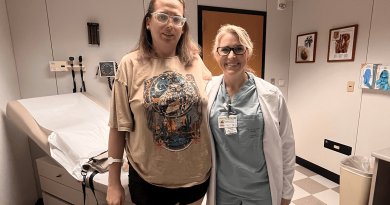Understanding small bowel obstructions: causes, symptoms and treatment
 The small bowel, or small intestine, is a key part of our digestive system. It helps us digest food and absorb nutrients. A small bowel obstruction (SBO) is when something blocks the small intestine, stopping food, fluids and gas from moving through. This can be a partial or complete blockage, and sometimes it’s a medical emergency.
The small bowel, or small intestine, is a key part of our digestive system. It helps us digest food and absorb nutrients. A small bowel obstruction (SBO) is when something blocks the small intestine, stopping food, fluids and gas from moving through. This can be a partial or complete blockage, and sometimes it’s a medical emergency.
What causes small bowel obstructions?
A common cause of SBO is scar tissue in the abdomen, called adhesions. These scars often form after surgery and can cause blockage weeks to years later. Other causes include hernias (when organs push through weak spots in the abdominal wall), tumors and volvulus (when intestines twist around themselves). Additionally, swallowing a foreign object can also lead to a blockage.
What are the symptoms of small bowel obstruction?
The main signs of SBO are:
- Cramping, on-and-off abdominal pain
- Feeling bloated or having a swollen stomach
- Vomiting, often with a greenish tint from bile backing up
- Difficulty eating or drinking or feeling full quickly
- No bowel movements or passing of gas
If you notice these symptoms, especially if they come on suddenly or are severe, seek medical help right away.
What can go wrong if SBO isn’t treated?
If SBO isn’t treated, it can lead to serious complications. When the intestines get blocked, fluids, gases and digestive juices build up inside. This puts a lot of pressure on the walls of the intestines. If this pressure keeps building up, it can cause the intestines to develop holes or get twisted (strangulated). If a hole (perforation) forms in the intestines, the contents of the intestine can leak into the abdomen, causing a life-threatening infection called sepsis. Sometimes, the blockage can cut off the blood supply to parts of the intestines. When this happens, the tissue in those areas can start to die. This condition, called tissue necrosis, needs emergency surgery to prevent further damage and save the affected tissue.
How is SBO diagnosed?
To diagnose SBO, medical providers will ask about your symptoms and do a physical exam. They’ll also want to know if you’ve had any surgeries, especially on your abdomen. Imaging tests like X-rays or CT scans are often used to see if there’s a blockage and where it might be. CT scans give a detailed view of the abdomen, facilitating the identification of the site, cause and extent of obstruction. CT scans can also detect complications such as perforation and the presence of hernias or tumors.

What are the treatment options for SBO?
The treatment for SBO depends on how severe it is and what’s causing it. If there’s no sign of severe complications, doctors might start with non-surgical methods. This could include:
- Stopping all food and drinks to give the intestines a break
- Providing fluids through an IV to keep you hydrated
- If you can’t eat or drink for a while, you might need to get nutrients through an IV, a process called total parenteral nutrition (TPN)
- Using a tube through the nose into the stomach (nasogastric tube) to remove air and fluid, thereby relieving distension and pressure within the gastrointestinal tract. This tube is typically connected to a suction device.
After you’ve had a nasogastric tube (NGT) inserted for a few hours, the next step might be a test called a small bowel follow through. This test helps providers understand what’s happening in your small intestine. Here’s what to expect:
First, they’ll use the NGT to send a special liquid (contrast) into your stomach. This liquid makes it easier to see what’s going on in your intestines during an X-ray. You’ll have a series of X-rays taken over time to track how the liquid moves through your small intestine.
The goal of this test is to look for anything unusual, like a blockage, a narrowing of the intestine, or parts of the intestine that aren’t moving normally. Sometimes, this contrast liquid also acts like a mild laxative, which can help things start moving in your intestines.
If the liquid doesn’t reach your large intestine, or if you still haven’t had a bowel movement after some time, it might mean there’s a serious blockage. In that case, surgery could be needed to clear the blockage and fix any damage.
Small bowel obstructions can be serious, so it’s important to recognize the symptoms and seek medical help if you suspect you have one. By understanding the causes, symptoms and treatment options, you can work with your healthcare team to get the care you need and prevent complications. Remember, if in doubt, always seek professional medical advice.
Learn more about GI Surgery at Baylor Medicine.
By Samra Radomsky, PA-C, instructor in the Michael E. DeBakey Department of Surgery



